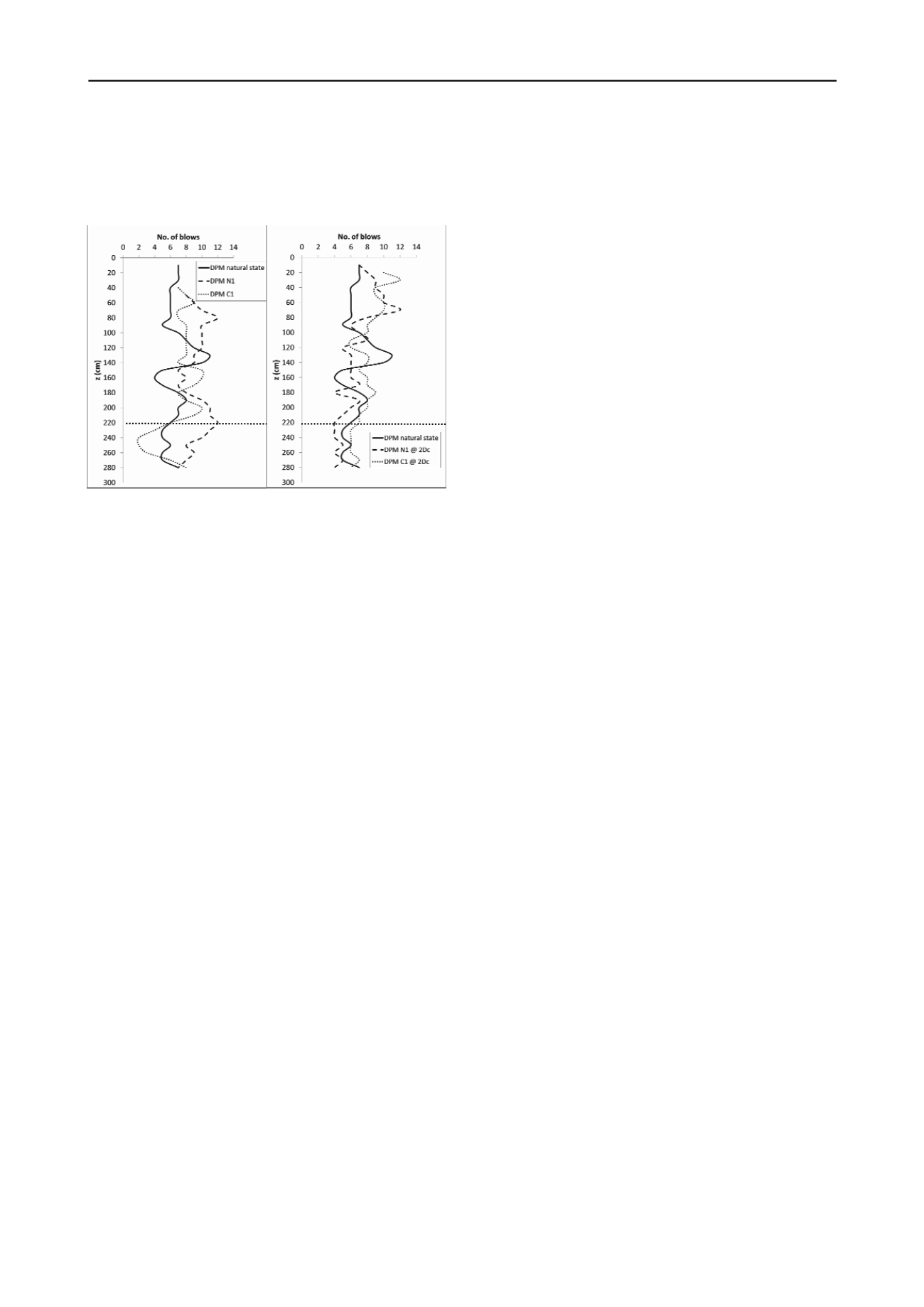
2436
Proceedings of the 18
th
International Conference on Soil Mechanics and Geotechnical Engineering, Paris 2013
4.4
Loess and sand mixture compacted columns
Finally, on the experimental polygon columns of 60% local
material (loess) and 40% sand were executed. For the execution
of these columns, cone 1 (30°) was also used as rammer.
Figure 9. DPM tests results for the column executed from a mixture of
loess and sand (N1): a) DPM in the centre of C1 and N1 columns; b)
DPM at 2Dc towards C1 and N1 columns
Figure 9a indicates that the results of the DPM tests carried
out in the centre of the column executed from a mixture of loess
and sand are better that those of the column made entirely of
loess. Moreover, it may be noticed that, unlike the compacted
loess column, the one made of mixture led to the improvement
of the material under the column's body.
Nevertheless, the results of the medium dynamic penetration
test carried out near the columns at a distance of 2Dc (~14 cm
indicate that the tamping effect is higher that in case of the loess
column.
5
CONCLUSIONS
Laboratory tests aimed at identifying a mixture of loess and
natural mineral materials, with better mechanical characteristics
and with reduced permeability compared to the one the loess
has in its natural state. From all the solutions proposed
(compacted loess, mixture of loess and sand and mixture of
loess, sand and bentonite) the last one (mixture 4 - sand and
ters are reached.
In-situ tests, performed with a penetrometer, simulated the
pacted sand
ithout
significantly exceeding the mechanical behaviour of natural
loess that has not been flooded.
By executing columns of compacted local material with
natural mineral materials, the mechanical behaviour of the
columns - loess complex that has not been flooded does not
improve, but this technique leads to some nuclei capable of
reducing the negative effect of the accidental flooding of loess.
6
REFERENCES
Bally R.J. and Antonescu I. 1971.
Loessoid soils in constructions
.
Tehnica Publishing House, Bucharest. (in Romanian)
Burlacu C. 2012.
Contributions to improvement solutions for weak
foundation soils
. PhD Thesis. Technical University of Civil
Engineering Bucharest, Romania.
Kirsch K. and Sondermann W. 2003. Geotechnical engineering
handbook, Volume 2: Procedures,
Chapter 2.1. Ground
improvement
, 1 - 50. Ernst & Sohn, Berlin, Germany.
Olinic E. 2012. Personal comunication.
Schlosser. 1997.
Exposé sur la themè: Améliorqtion et renforce,ent des
sols
. Proceedings of the Fourteenth International Confrence on Soil
Mechanics and Fountation Engineering, Volume 4, 2445 – 2466,
Hamburg, Germany.
NP 125:2010.
Normative for foundation of buildings on moisture –s
sensitive, collapsible soils.
(in Romanian)
)
bentonite, mixed with loess after drying) seems to be the
optimal one due to the wide domain in which optimal
compaction parame
Concerning mechanical characteristics, no significant
differences seem to exist between the analysed mixtures, but
one can notice that water sensitivity is significantly reduced and
that, compared to the flooded loess, the values obtained are
significantly better.
execution of loess columns and of loess with com
columns, at a scale of 1:5. Both the quality of the material in the
column body and the effect on the surrounding ground were
verified by typical tests. The sand improves the mechanical
behaviour of the material in the column body, w


